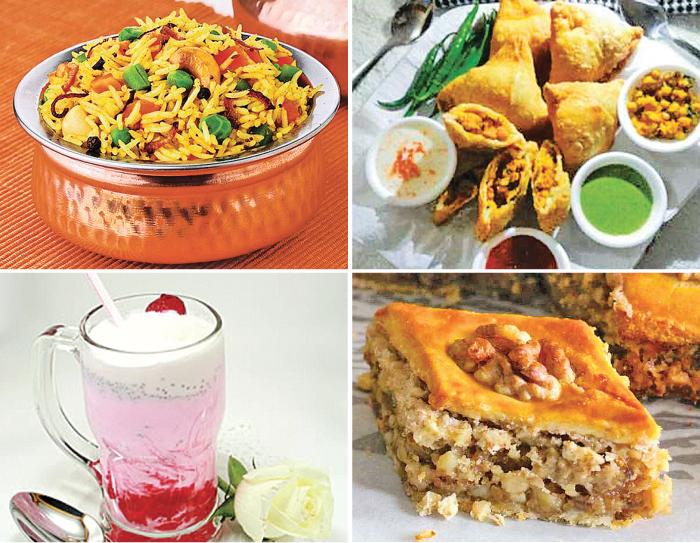
The ninth month of the Islamic calendar heralds the period of fasting. It is a time of deep spiritual reflection, renunciation and devotion. The word Ramadan is derived from the Arabic word ramadi- meaning dryness. Thousands of youth and young adults faithfully adhere to the sacred fast: whilst working or attending university. Fasting is observed from sunrise to sunset. The observance is one of the 5 pillars of Islam. Iftar- is the symbolic meal that breaks the days fast. In order to understand the rich cultural and culinary heritage of the Iftar, I sat down with my friend Nadia Issadeen at Movenpick Colombo. In keeping with tradition the fast is broken by eating 3 dates. This is followed by drinking rice based porridge or one can indulge in a glass of faluda, chilled milk infused with sweet rose essence. Arabic food can be traced back to centuries. Its menus are strongly influenced by the Persian and Turkish civilizations. With the region positioned on the cross roads of the spice route, Arabian dishes display refined taste and skillful preparation. Ancient adherents of Islam based their food on pine nuts, dates, eggplant, cinnamon, rice, sugar, sesame, and saffron. In terms of meat there was an abundance of beef, goat meat and poultry. It is interesting to note that the ancient Arabs also used a mortar and pestle to crush their garlic and spices like we still do today, in many regions of Asia. Some of the ancient dishes used at Iftar include-
Milk, water and dates-Muslims traditionally break their fast by consuming any of these foods, in adherence to the teachings of the Prophet Mohammed. Amar al-Deen Sheets of apricot are cut and soaked in water for hours. The solution is then mixed with enough water to make it smooth. Erk Soos Extracts of the liquorice plant are mixed with water to make this drink that is served in Egypt and the Levant (Jordan, Lebanon, Palestine and Syria). Tamar Hindi Tamar Hindi, or Tamarind, is a sour chilled drink usually sold throughout the year in several Arab countries. Jellab A syrup made of grape molasses mixed with rose water and sugar, then poured over ice and decorated with pine nuts. Rice-based dishes Biryani, Mansaf and Kabsas make up an integral part of Ramadan meals. Biriyani has made a strong influence on Sri Lankans, and is served at weddings and celebrations by even non- Muslim communities. This is how food can beautifully connect ethnic groups together.
Today the hit in Colombo among the youth is the succulent pot biriyani, with Pakistan origins. Stuffed vegetables Peppers, eggplants, tomatoes, zucchinis and vine leaves are stuffed with flavored rice to make what is commonly known in the Arab world as Mahshi. It is mainly famous in Egypt. Couscous, A North African dish of granulated semolina, served with meat, chicken, fish or vegetables. Masgouf , A traditional Iraqi dish of baked fish. Harees, A popular dish in the Gulf, it consists of coarsely-ground wheat buried underground with chicken or meat. Kunafa, a sweet made from spun shredded wheat. It can be filled with cream, cheese, or nuts and raisins, depending on which Arab region it comes from. Atayef, Originally famous in Egypt and the Levant, these Arabic pancakes are usually filled with cheese or nuts, and served with a sugary syrup or honey.
Perhaps it is from this that we find our grated coconut filled pancakes. Luqaimat Small, sweet dumplings made from butter, sugar, milk and flour. They are called Luqaimat in the Gulf, Awamat in the Levant, and Zalabia in Egypt. Soups Soups are essential components of Ramadan meals. Chicken, lentil, vegetable and tomato soups are commonly served. Salads and beans, Green salads include Fattoush and Tabbouleh. Bean dishes such as Hummus (chickpeas) are also common, because they keep people full for long periods. While these original dishes maybe hard to make, local hose wives display their own versions of fine food. Wattalappan (local jaggery – egg based pudding) is a desired dessert.
As I began to understand the rituals Nadia and I ate some of the following dishes- yogurt cucumber salad, couscous with lamb, cauliflower with tahini, zatar bread, shish kebab, tandoori chicken and lamb kofta kebab. This was followed by baklava and lamb kheer.
During this month if you walk along some of the predominantly Muslim areas in Colombo like Maradna and Slave Island you can witness small kiosk like carts selling deep fried samosa and rolls filled with beef and goat meat, which I used to cherish eating with my classmates Shahabdeen and Safraz Zubair. Whilst fasting can induce discipline I assume it can also direct our minds to understand the elements of hunger and poverty which are global issues recognized even by the United Nations. Again Ramadan whilst being exclusive to the Muslim people and youth can teach all Sri Lankans the fundamentals of sharing and caring.
As Nadia opined ““Ramadan is observed out of sincere faith. It teaches us self-discipline and we spend more time with family during this month. It’s a holy month that brings us together, it is a month to revive the faith and connect with god on a spiritual level strengthening the connection. It’s a holy month where you can really put your time and effort to perform all religious activities”.
